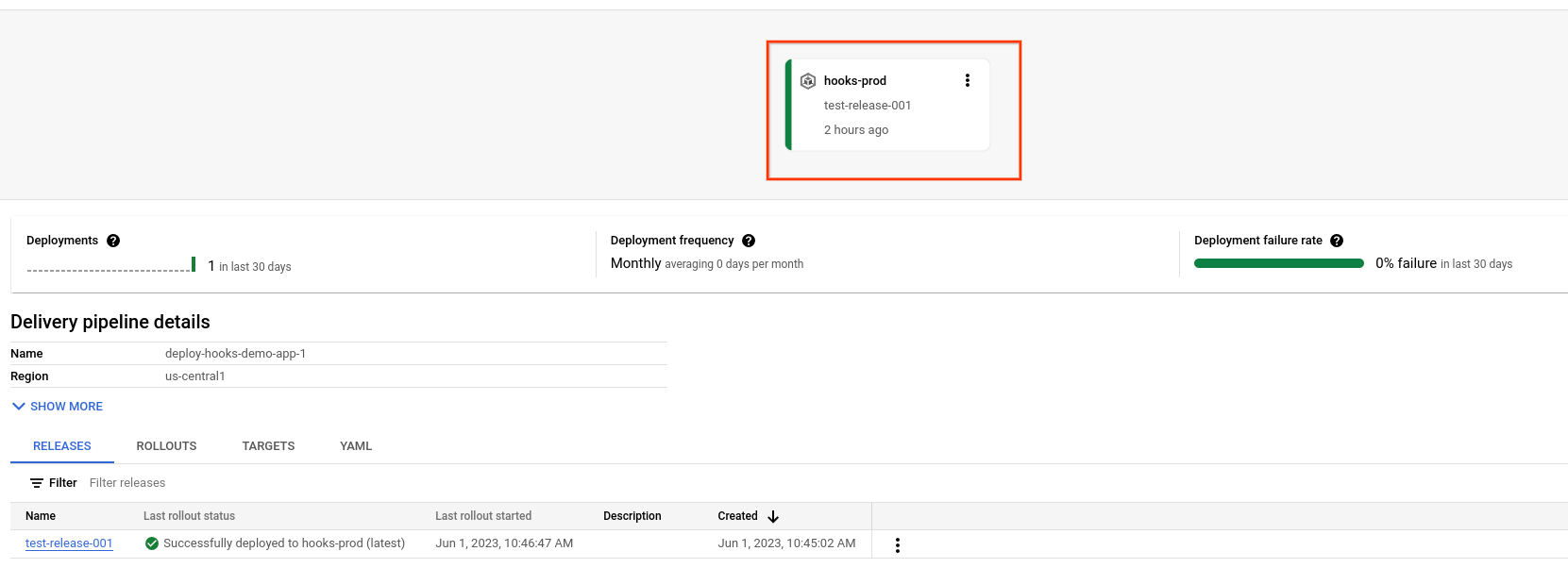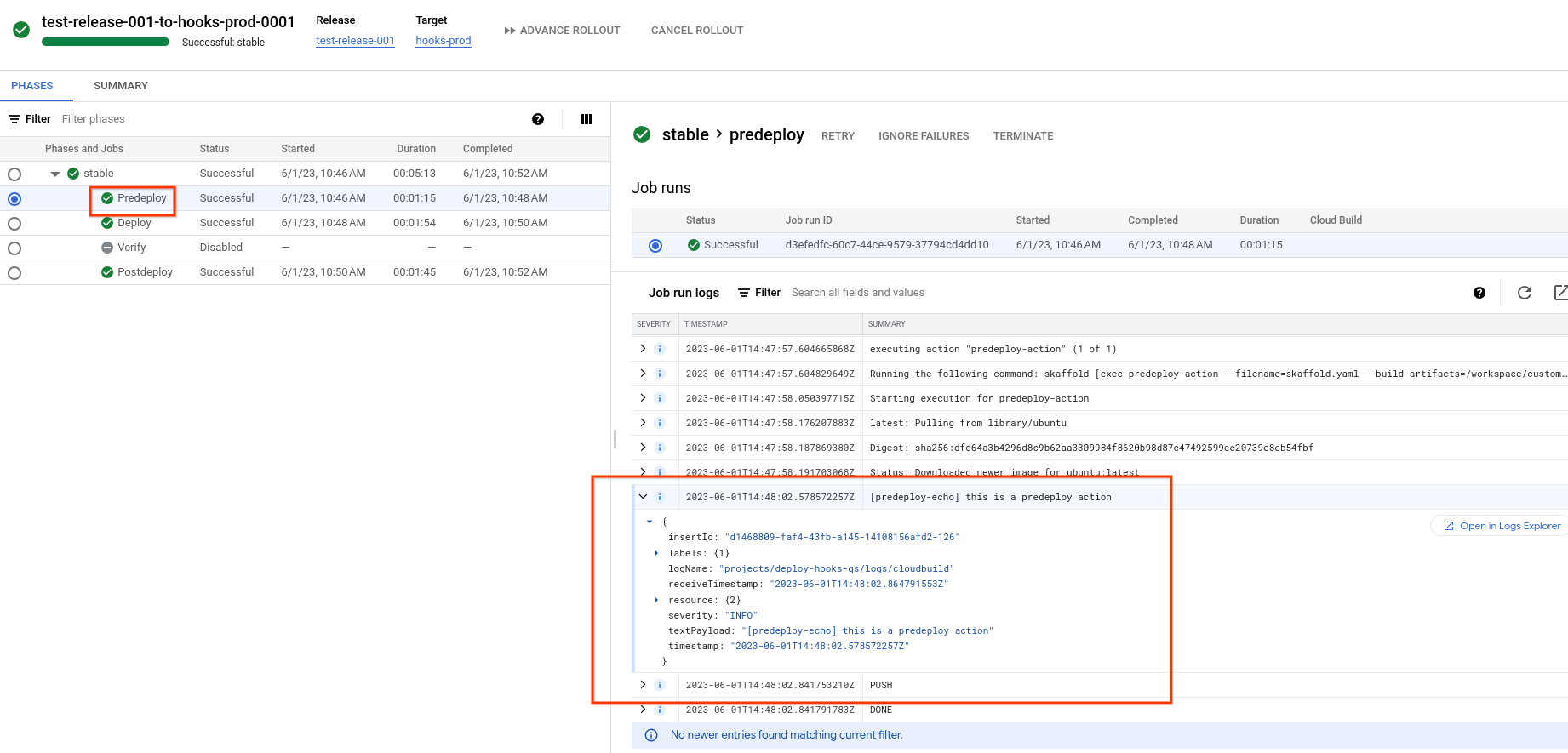Run hooks before and after deploying
This quickstart shows you how to run a deploy hook—an arbitrary program to run before or after you deploy using Cloud Deploy.
In this quickstart, you'll do the following:
Create one GKE cluster or one Cloud Run service.
You can use an GKE Enterprise cluster for this too, but this quickstart uses GKE and Cloud Run only.
Create a Skaffold configuration and either a Kubernetes manifest or a Cloud Run service definition.
The Skaffold configuration file is where you configure the deploy hooks to run. You identify a container to run before deploying, and a container to run after deploying.
Define your Cloud Deploy delivery pipeline and deployment target.
In the delivery pipeline configuration, you'll reference the deploy hooks that were defined in
skaffold.yaml, to run those hooks.This pipeline includes only one stage and uses only one target.
Create a release, which automatically deploys to the target.
One of the hooks is run before the application is deployed, and the other is run after.
View the results of the pre- and post-deploy hooks in the Cloud Build logs, using the Cloud Deploy Rollout details page in Google Cloud console.
Before you begin
- Sign in to your Google Cloud account. If you're new to Google Cloud, create an account to evaluate how our products perform in real-world scenarios. New customers also get $300 in free credits to run, test, and deploy workloads.
-
In the Google Cloud console, on the project selector page, select or create a Google Cloud project.
-
Make sure that billing is enabled for your Google Cloud project.
-
Enable the Cloud Deploy, Cloud Build, GKE, Cloud Run, and Cloud Storage APIs.
- Install the Google Cloud CLI.
-
To initialize the gcloud CLI, run the following command:
gcloud init -
In the Google Cloud console, on the project selector page, select or create a Google Cloud project.
-
Make sure that billing is enabled for your Google Cloud project.
-
Enable the Cloud Deploy, Cloud Build, GKE, Cloud Run, and Cloud Storage APIs.
- Install the Google Cloud CLI.
-
To initialize the gcloud CLI, run the following command:
gcloud init - Make sure the default
Compute Engine service account has sufficient permissions.
The service account might already have the necessary permissions. These steps are included for projects that disable automatic role grants for default service accounts.
- First add the
clouddeploy.jobRunnerrole:gcloud projects add-iam-policy-binding PROJECT_ID \ --member=serviceAccount:$(gcloud projects describe PROJECT_ID \ --format="value(projectNumber)")-compute@developer.gserviceaccount.com \ --role="roles/clouddeploy.jobRunner" - Add the developer role for your specific runtime.
- For GKE:
gcloud projects add-iam-policy-binding PROJECT_ID \ --member=serviceAccount:$(gcloud projects describe PROJECT_ID \ --format="value(projectNumber)")-compute@developer.gserviceaccount.com \ --role="roles/container.developer" - For Cloud Run:
gcloud projects add-iam-policy-binding PROJECT_ID \ --member=serviceAccount:$(gcloud projects describe PROJECT_ID \ --format="value(projectNumber)")-compute@developer.gserviceaccount.com \ --role="roles/run.developer" -
Add the
iam.serviceAccountUserrole, which includes theactAspermission to deploy to the runtime:gcloud iam service-accounts add-iam-policy-binding $(gcloud projects describe PROJECT_ID \ --format="value(projectNumber)")-compute@developer.gserviceaccount.com \ --member=serviceAccount:$(gcloud projects describe PROJECT_ID \ --format="value(projectNumber)")-compute@developer.gserviceaccount.com \ --role="roles/iam.serviceAccountUser" \ --project=PROJECT_ID
If you already have the CLI installed, make sure you're running the latest version:
gcloud components update
Create your runtime environment
If you're deploying to Cloud Run, you can skip this command.
For GKE, create one cluster: deploy-hooks-cluster, with
default settings. The cluster's Kubernetes API endpoint must be
network-reachable from the public internet. GKE clusters
are externally accessible by default.
gcloud container clusters create-auto deploy-hooks-cluster \
--project=PROJECT_ID \
--region=us-central1
Prepare your Skaffold configuration and application manifest
Cloud Deploy uses Skaffold to provide the details for what to deploy and how to deploy it to your target.
In this quickstart, you create a skaffold.yaml file, which identifies the
manifest to be used to deploy the sample app, and also identifies the containers
to run before and after deployment (the deploy hooks).
Open a terminal window.
Create a new directory and navigate into it.
GKE
mkdir deploy-hooks-gke-quickstart cd deploy-hooks-gke-quickstartCloud Run
mkdir deploy-hooks-run-quickstart cd deploy-hooks-run-quickstartCreate a file named
skaffold.yamlwith the following contents:GKE
apiVersion: skaffold/v4beta7 kind: Config manifests: rawYaml: - k8s-pod.yaml deploy: kubectl: {} customActions: - name: predeploy-action containers: - name: predeploy-echo image: ubuntu command: ["/bin/sh"] args: ["-c", 'echo "this is a predeploy action"' ] - name: postdeploy-action containers: - name: postdeploy-echo image: ubuntu command: ["/bin/sh"] args: ["-c", 'echo "this is a postdeploy action"' ]Cloud Run
apiVersion: skaffold/v4beta7 kind: Config manifests: rawYaml: - service.yaml deploy: cloudrun: {} customActions: - name: predeploy-action containers: - name: predeploy-echo image: ubuntu command: ["/bin/sh"] args: ["-c", 'echo "this is a predeploy action"' ] - name: postdeploy-action containers: - name: postdeploy-echo image: ubuntu command: ["/bin/sh"] args: ["-c", 'echo "this is a postdeploy action"' ]This file includes the
customActions:stanza. This defines the containers to run before and after deploying—the hooks.See the
skaffold.yamlreference for more information about this configuration file.Create the definition for your application—a service definition for Cloud Run or a Kubernetes manifest for GKE.
GKE
Create a file named
k8s-pod.yaml, with the following contents:apiVersion: v1 kind: Pod metadata: name: my-hooks-pod spec: containers: - name: nginx image: my-app-imageThis file is a basic Kubernetes manifest, which is applied to the cluster to deploy the application. The container image to deploy is set here as a placeholder,
my-app-image, which is replaced with the specific image when you create the release.Cloud Run
Create a file named
service.yaml, with the following contents:apiVersion: serving.knative.dev/v1 kind: Service metadata: name: my-hooks-run-service spec: template: spec: containers: - image: my-app-imageThis file is a simple Cloud Run service definition, which is used to deploy the application. The container image to deploy is set here as a placeholder,
my-app-image, which is replaced with the specific image when you create the release.
Create your delivery pipeline and target
You can define your pipeline and target in one file or in separate files. In this quickstart, you create a single file.
Create your delivery pipeline and target definition:
GKE
In the
deploy-hooks-gke-quickstartdirectory, create a new file:clouddeploy.yaml, with the following contents:apiVersion: deploy.cloud.google.com/v1 kind: DeliveryPipeline metadata: name: deploy-hooks-demo-app-gke-1 description: main application pipeline serialPipeline: stages: - targetId: hooks-staging profiles: [] strategy: standard: predeploy: actions: ["predeploy-action"] postdeploy: actions: ["postdeploy-action"] --- apiVersion: deploy.cloud.google.com/v1 kind: Target metadata: name: hooks-staging description: hooks staging cluster gke: cluster: projects/PROJECT_ID/locations/us-central1/clusters/deploy-hooks-clusterCloud Run
In the
deploy-hooks-run-quickstartdirectory, create a new file:clouddeploy.yaml, with the following contents:apiVersion: deploy.cloud.google.com/v1 kind: DeliveryPipeline metadata: name: deploy-hooks-demo-app-run-1 description: main application pipeline serialPipeline: stages: - targetId: hooks-staging profiles: [] strategy: standard: predeploy: actions: ["predeploy-action"] postdeploy: actions: ["postdeploy-action"] --- apiVersion: deploy.cloud.google.com/v1 kind: Target metadata: name: hooks-staging description: staging Run service run: location: projects/PROJECT_ID/locations/us-central1Register your pipeline and targets with the Cloud Deploy service:
gcloud deploy apply --file=clouddeploy.yaml --region=us-central1 --project=PROJECT_ID
You now have a delivery pipeline, with one target, ready to deploy your application and run your pre-deploy and post-deploy jobs.
Confirm your pipeline and targets:
In the Google Cloud console, navigate to the Cloud Deploy Delivery pipelines page to view of list of your available delivery pipelines.
Open the Delivery pipelines page
The delivery pipeline you just created is shown, with one target listed in the Targets column.

Create a release
A release is the central Cloud Deploy resource representing the changes being deployed. The delivery pipeline defines the lifecycle of that release. See Cloud Deploy service architecture for details about that lifecycle.
GKE
Run the following command from the deploy-hooks-gke-quickstart
directory to create a release resource that represents the container
image to deploy:
gcloud deploy releases create test-release-001 \
--project=PROJECT_ID \
--region=us-central1 \
--delivery-pipeline=deploy-hooks-demo-app-gke-1 \
--images=my-app-image=gcr.io/google-containers/nginx@sha256:f49a843c290594dcf4d193535d1f4ba8af7d56cea2cf79d1e9554f077f1e7aaa
Notice the
--images= flag,
which you use to replace the placeholder (my-app-image) in the
manifest
with the specific, SHA-qualified image. Google recommends that you
templatize your manifests this way, and that you use SHA-qualified image
names at release creation.
Cloud Run
Run the following command from the deploy-hooks-run-quickstart
directory to create a release resource that represents the container
image to deploy:
gcloud deploy releases create test-release-001 \
--project=PROJECT_ID \
--region=us-central1 \
--delivery-pipeline=deploy-hooks-demo-app-run-1 \
--images=my-app-image=us-docker.pkg.dev/cloudrun/container/hello@sha256:4a856b6f1c3ce723a456ddc2adfbb794cbfba93f727e2d96fcf6540bd0d6fff4
Notice the
--images= flag,
which you use to replace the placeholder (my-app-image) in the
service definition
with the specific, SHA-qualified image. Google recommends that you
templatize your service and job definitions this way, and that you use
SHA-qualified image names at release creation.
As with all releases (unless they include --disable-initial-rollout),
Cloud Deploy automatically creates a
rollout resource too. The application is
automatically deployed into the one target configured for this delivery
pipeline.
Also, the pre-deploy job runs before the application is deployed, and the post-deploy job runs after.
View the results in Google Cloud console
After a few minutes, your release is deployed into your target runtime.
The pre- and post-deploy hooks that we configured (for example purposes) print strings to the Cloud Build logs. We can view those logs to confirm that the hooks worked as expected.
In the Google Cloud console, navigate to the Cloud Deploy Delivery pipelines page to view your delivery pipeline ("deploy-hooks-demo-app-gke-1" or "deploy-hooks-demo-app-run-1").
Click the name of your delivery pipeline ("deploy-hooks-demo-app-gke-1" or "deploy-hooks-demo-app-run-1").
The pipeline visualization shows the app's deployment status. Because there's only one stage in the pipeline, the visualization shows only one node.

And your release is listed on the Releases tab under Delivery pipeline details.
Click the Rollouts tab, under Delivery pipeline details.
Click the rollout name to view the rollout details.

Predeploy and Postdeploy are listed as jobs.
Click Predeploy
The job run log is displayed.
Scroll down in the list of log entries to find
predeploy-echo, and click it.
Notice the
textPayload. That string is what was configured in thepredeploy-actionin your Skaffold configuration.Click the Postdeploy job, and find the
postdeploy-echolog entry.
Clean up
To avoid incurring charges to your Google Cloud account for the resources used on this page, follow these steps.
Delete the GKE cluster or Cloud Run service:
GKE
gcloud container clusters delete deploy-hooks-cluster --region=us-central1 --project=PROJECT_IDCloud Run
gcloud run services delete my-hooks-run-service --region=us-central1 --project=PROJECT_IDDelete the delivery pipeline, target, release, and rollout:
gcloud deploy delete --file=clouddeploy.yaml --force --region=us-central1 --project=PROJECT_IDDelete the Cloud Storage buckets that Cloud Deploy created.
One ends with
_clouddeploy, and the other is[region].deploy-artifacts.[project].appspot.com.
That's it, you completed this quickstart!
